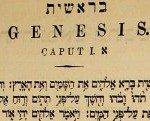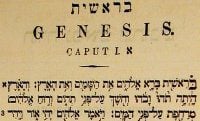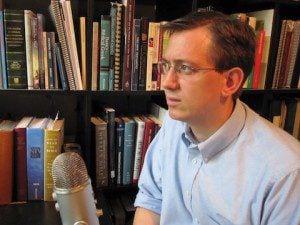First of all, I’ve made a Facebook page for Benjamin the Scribe. I’m not sure what one does with such pages, but feel free to become a fan there.
Second, I’m hunkering down to finish my Genesis book, in preparation for something new and big, that I hope to be able to announce in December, if all goes well. Fingers crossed.
Third, a bunch of the New Testament books by N.T. Wright are for sale on Kindle right now, as part of a larger sale by Fortress Press which includes books by Wright, Brueggemann, Bonhoeffer (mentioned in General Conference!), and others.
Fourth, since I’m making announcements, here’s my usual plug for supporting my research by making your Amazon purchases through this link.
The chapters today are Paul’s final travels, ending in Rome. Indeed, it reads a bit like a travelogue, as Paul returns to Jerusalem, and then travels under Roman custody by stages to Rome.
One thing of note, although we’ve seen them before in chapter 16, is that pronoun “we”, which starts immediately in 21:1.
“The surprising shift to the first-person plural (16:10) introduces the first of four “we” passages in Acts (16:10-17; 20:5-15; 21:1-18; 27:1-28:16). These intriguing references may signify that the author of these sections here joins Paul’s entourage and thus writes from the perspective of an eyewitness. By extension, this same traveling companion may very well have written the entire book, enhancing his overall credibility by subtle, occasional references to what he saw and experienced personally. Or, these sections may be travel diaries from an unnamed traveling companion, employed by the author, though loosely edited. Tradition has seen behind the “we” a reference to “Luke the physician,” elsewhere mentioned as Paul’s companion during his imprisonments (Col. 4:14; Philem. 24; 2 Tim. 4:11). The change may be purely stylistic, however, yielding no concrete historical information either about Paul’s traveling companions, eyewitnesses to these events, or the authorship of these sections and the book as a whole.”- Harper’s Bible Commentary (Harper’s is a 1-volume commentary.)
For the rest, I’ll focus on Paul and Jerusalem.
First, note in Act 21:11, that there are still prophets, receiving revelation, and teaching it via symbolic acts, which happens in the Old Testament often. Agabus does not appear to be hold any office, and indeed, prophet is not a formal office. He’s just spiritually in tune. Earlier in Acts, he had prophesied a famine (Acts 11:27-30) and now he warns Paul about what will happen to him if he goes… but he goes anyway.
Once in Jerusalem, Paul visits James, in particular. (This is probably James, Jesus’ brother, who led the Jerusalem Church, not James John’s brother, son of Zebedee.) We learn that many Jews are believers in Jesus, but embrace the law (21:20). Paul’s rep in Jerusalem is that he’s a traitor, that he preaches against the Temple and Torah. So again, let’s split some hairs. Paul joins four men who have taken a Nazarite vow, which they end by shaving their heads. (See Numbers 6.) Paul’s preaching has been that Torah observance is not the means to salvation, and that non-Jewish converts to Christianity don’t need to keep most of it (but note Gentile converts “should abstain from what has been sacrificed to idols and from blood and from what is strangled and from fornication”) …. but should Jews who accept Jesus keep the Torah? The answer, at least here, seems to be “yes, they should.”
This is what concerns those who are ‘zealous for the law’ (v. 20; cf. ACTS 5:17), and it is not a problem about the past (are Jewish Christians saved by the law?) but about the future (should Jewish Christians go on keeping the law?): as so often, it is in the rituals surrounding the birth of children that crucial questions of identity crystallize. James suggests that Paul should demonstrate publicly that he himself remains an observant Jew by sponsoring and joining four men who are going through the procedures of a nazirite vow (vv. 23–4), and he agrees to do this (v. 26; cf. 18:18). The same issue arises here as over the cirumcision of Timothy (see ACTS 16:1–5): is this action unthinkable for the Paul of the epistles (as some have suggested) or does it fall under the rubric of being ‘all things to all people’ (1 Cor 9:22)?- Oxford Bible Commentary.
So Paul goes into the temple, a riot breaks out, and Roman soldiers show up almost instantly. Good times.
How and why does this happen?
First, the Jerusalem temple complex made by Herod was huge. Massive. You really can’t tell how massive until you’re there, dwarfed by an 80-ton ashlar. Then you realize the walls are made of hundreds of these. The disciples were rightly astonished when Jesus talked about “all these stones” being thrown down.
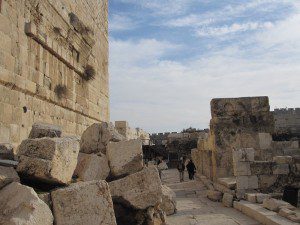
Second, remember that in the New Testament, “temple” translates two different words. One refers to the entire temple complex, the other to a much smaller, holier subset of that complex.
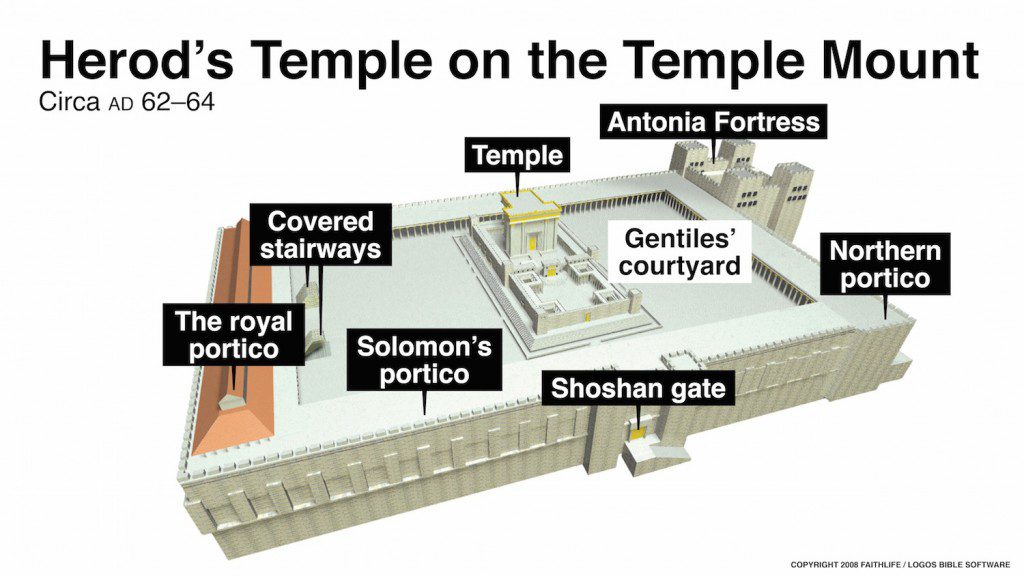
Right outside the naos, the temple proper, in the Gentiles Courtyard was a small wall, about 5 feet high, the soreg wall or wall of separation between Jew and non-Jew. (This is probably what dividing wall Christ has torn down in Eph 2:14.) At regular intervals, it had carved signs in Greek, saying, in essence “Any non-Israelite who crosses this line shall bear the responsibility for his own death.” Only Israelites could proceed past this wall. This was the one Jewish law involving capital punishment where Rome had delegated their power. That is, a Gentile who crossed this wall could be put to death without having to get Rome’s permission.
A complete plaque was discovered in the late 1800s, and a fragment later, see the pics here on the left.
Paul is recognized as that traitor preaching against Torah in the company of Gentiles, and suspicion that he has brought a Gentile inside the soreg wall escalates quickly into a riot.
In the pic above, on the NW corner of the temple was a roman fortress with a stairway down into the court of the Gentiles. Romans knew that if there was another Judean revolt, it would start there. So when they see a riot in the temple, down the soldiers go, and grab Paul… who turns out not to be that revolutionary Egyptian, but a fluent speaker of Greek, who wishes to address the crowd, which he does. (“There’s been a riot about me. Guess I’ll bear my testimony.”Ok Paul.) The Romans decide to beat out of him the reason for the riot, and he coyly asks why they’re beating a citizen, which puts real fear into them. The law applied differently to slaves, freemen, and citizens, and they were in real trouble. Paul eventually appeals to Casear, and off to Rome he goes.
Lastly, as always, you can support this site and my research by making Amazon purchases through this link, or the Support My Research links at the bottom of the About page. You can get updates by email whenever a post goes up (subscription box on the right). If you friend me on Facebook, please drop me a note telling me you’re a reader.



